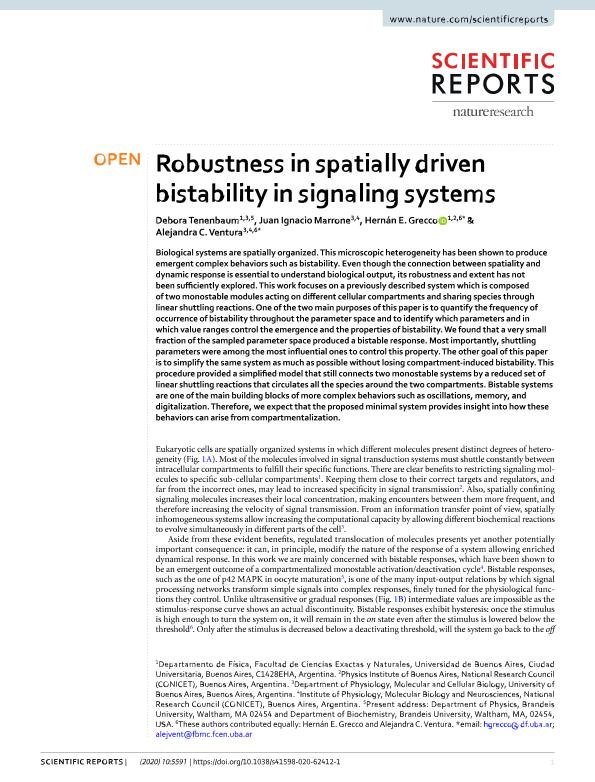Mostrar el registro sencillo del ítem
dc.contributor.author
Tenenbaum, Debora
dc.contributor.author
Marrone, Juan Ignacio

dc.contributor.author
Grecco, Hernan Edgardo

dc.contributor.author
Ventura, Alejandra

dc.date.available
2021-10-01T02:23:05Z
dc.date.issued
2020-03-27
dc.identifier.citation
Tenenbaum, Debora; Marrone, Juan Ignacio; Grecco, Hernan Edgardo; Ventura, Alejandra; Robustness in spatially driven bistability in signaling systems; Nature Research; Scientific Reports; 10; 5591; 27-3-2020; 1-10
dc.identifier.issn
2045-2322
dc.identifier.uri
http://hdl.handle.net/11336/142174
dc.description.abstract
Biological systems are spatially organized. This microscopic heterogeneity has been shown to produce emergent complex behaviors such as bistability. Even though the connection between spatiality and dynamic response is essential to understand biological output, its robustness and extent has not been sufficiently explored. This work focuses on a previously described system which is composed of two monostable modules acting on different cellular compartments and sharing species through linear shuttling reactions. One of the two main purposes of this paper is to quantify the frequency of occurrence of bistability throughout the parameter space and to identify which parameters and in which value ranges control the emergence and the properties of bistability. We found that a very small fraction of the sampled parameter space produced a bistable response. Most importantly, shuttling parameters were among the most influential ones to control this property. The other goal of this paper is to simplify the same system as much as possible without losing compartment-induced bistability. This procedure provided a simplified model that still connects two monostable systems by a reduced set of linear shuttling reactions that circulates all the species around the two compartments. Bistable systems are one of the main building blocks of more complex behaviors such as oscillations, memory, and digitalization. Therefore, we expect that the proposed minimal system provides insight into how these behaviors can arise from compartmentalization.
dc.format
application/pdf
dc.language.iso
eng
dc.publisher
Nature Research
dc.rights
info:eu-repo/semantics/openAccess
dc.rights.uri
https://creativecommons.org/licenses/by-nc-sa/2.5/ar/
dc.subject
bistability
dc.subject
compartmentalization
dc.subject
signaling networks
dc.subject
dynamical systems
dc.subject.classification
Otras Ciencias Físicas

dc.subject.classification
Ciencias Físicas

dc.subject.classification
CIENCIAS NATURALES Y EXACTAS

dc.title
Robustness in spatially driven bistability in signaling systems
dc.type
info:eu-repo/semantics/article
dc.type
info:ar-repo/semantics/artículo
dc.type
info:eu-repo/semantics/publishedVersion
dc.date.updated
2021-09-07T18:30:09Z
dc.journal.volume
10
dc.journal.number
5591
dc.journal.pagination
1-10
dc.journal.pais
Reino Unido

dc.description.fil
Fil: Tenenbaum, Debora. Consejo Nacional de Investigaciones Científicas y Técnicas. Oficina de Coordinación Administrativa Ciudad Universitaria. Instituto de Fisiología, Biología Molecular y Neurociencias. Universidad de Buenos Aires. Facultad de Ciencias Exactas y Naturales. Instituto de Fisiología, Biología Molecular y Neurociencias; Argentina. Brandeis University; Estados Unidos
dc.description.fil
Fil: Marrone, Juan Ignacio. Universidad de Buenos Aires. Facultad de Ciencias Exactas y Naturales. Departamento de Física; Argentina. Consejo Nacional de Investigaciones Científicas y Técnicas; Argentina
dc.description.fil
Fil: Grecco, Hernan Edgardo. Consejo Nacional de Investigaciones Científicas y Técnicas. Oficina de Coordinación Administrativa Ciudad Universitaria. Instituto de Fisiología, Biología Molecular y Neurociencias. Universidad de Buenos Aires. Facultad de Ciencias Exactas y Naturales. Instituto de Fisiología, Biología Molecular y Neurociencias; Argentina
dc.description.fil
Fil: Ventura, Alejandra. Universidad de Buenos Aires. Facultad de Ciencias Exactas y Naturales. Departamento de Física; Argentina. Consejo Nacional de Investigaciones Científicas y Técnicas; Argentina
dc.journal.title
Scientific Reports
dc.relation.alternativeid
info:eu-repo/semantics/altIdentifier/url/http://www.nature.com/articles/s41598-020-62412-1
dc.relation.alternativeid
info:eu-repo/semantics/altIdentifier/doi/http://dx.doi.org/10.1038/s41598-020-62412-1
Archivos asociados
